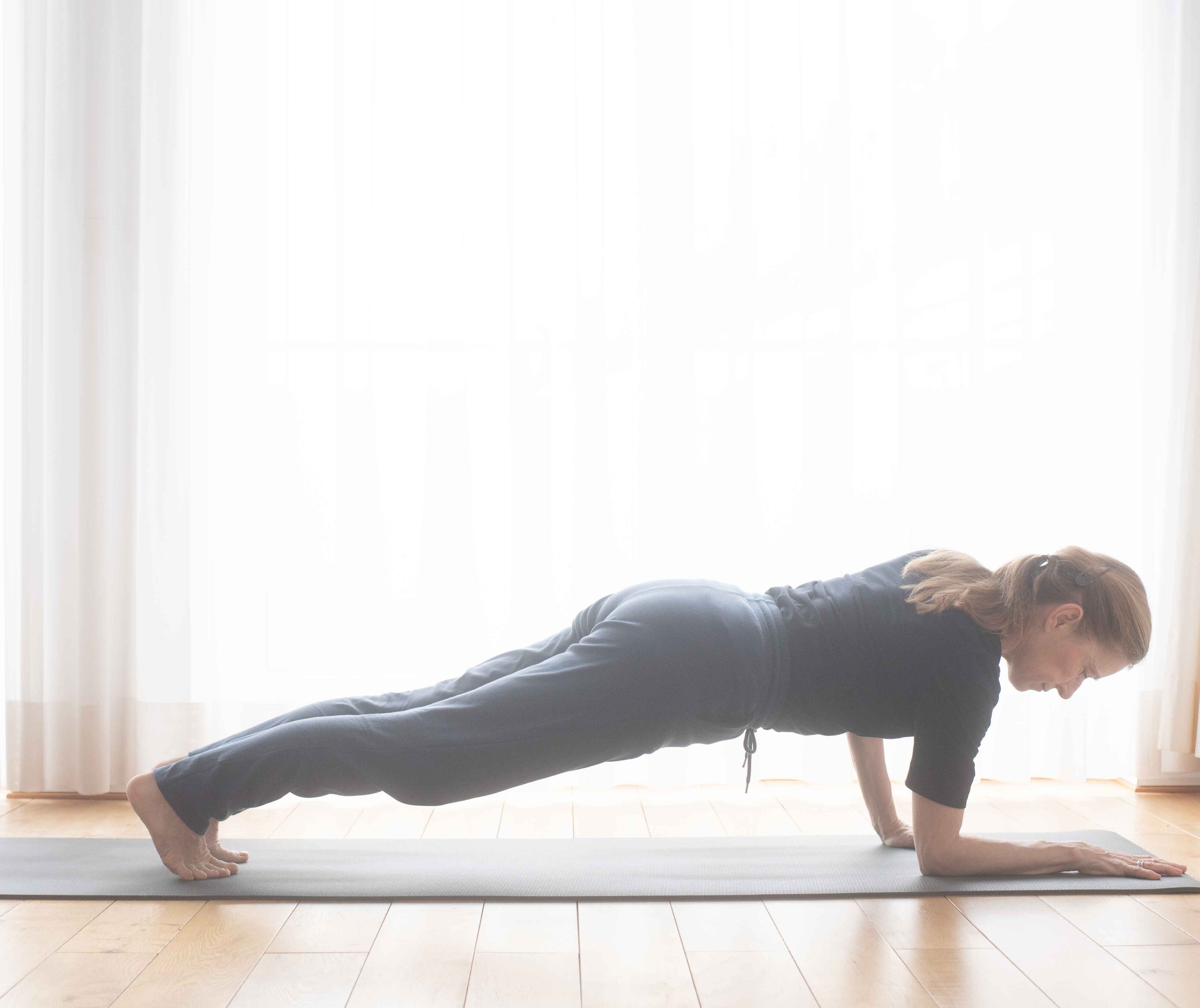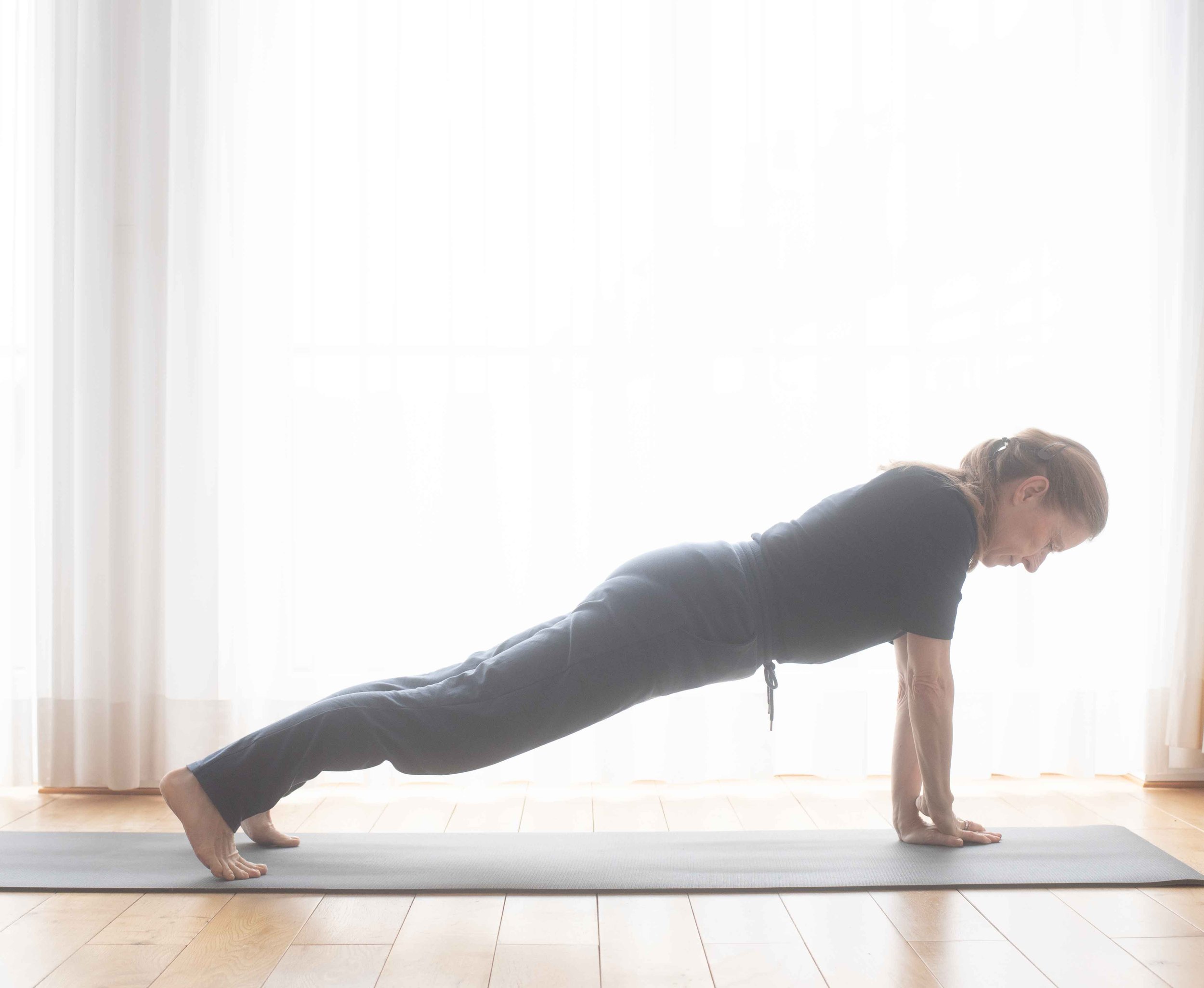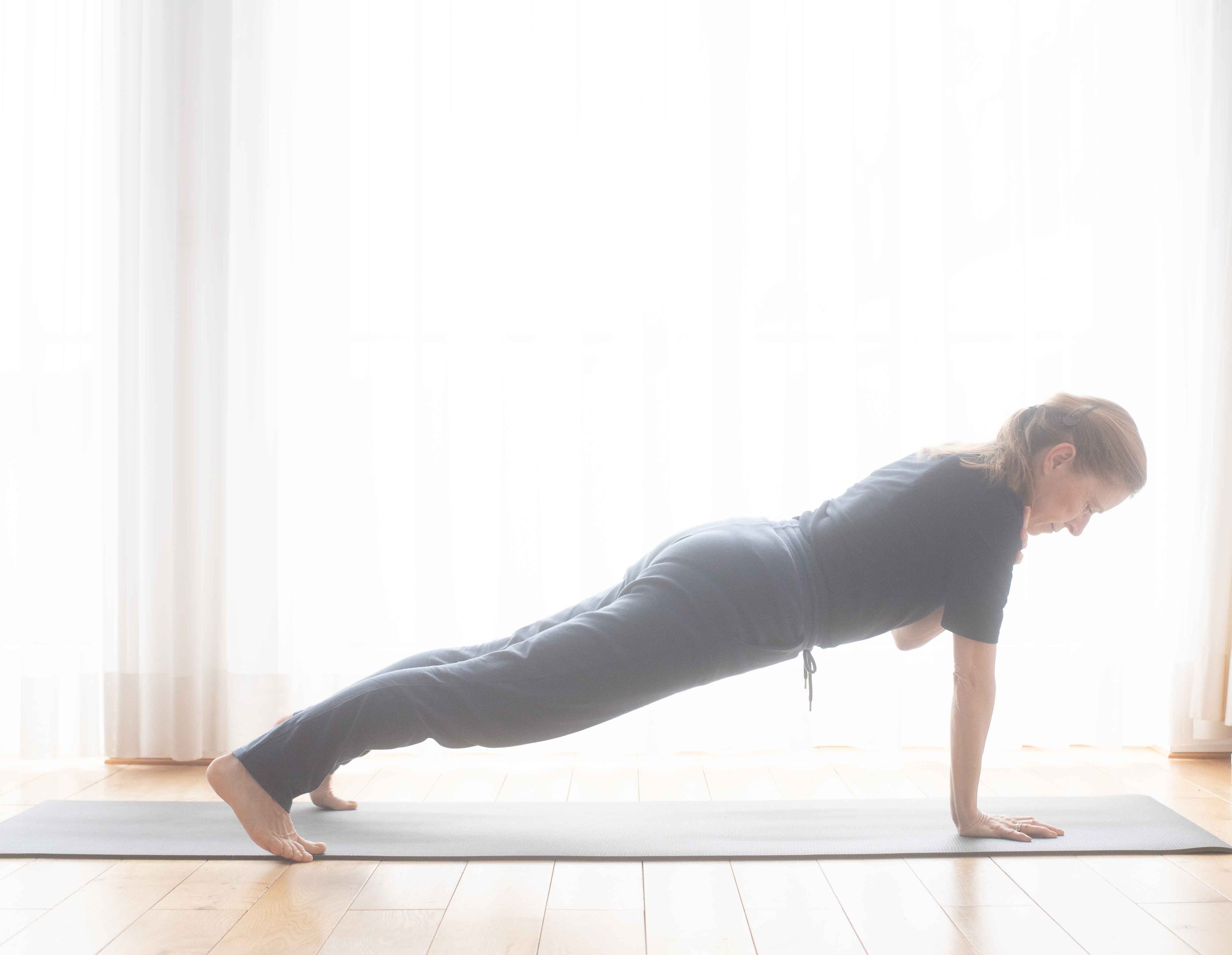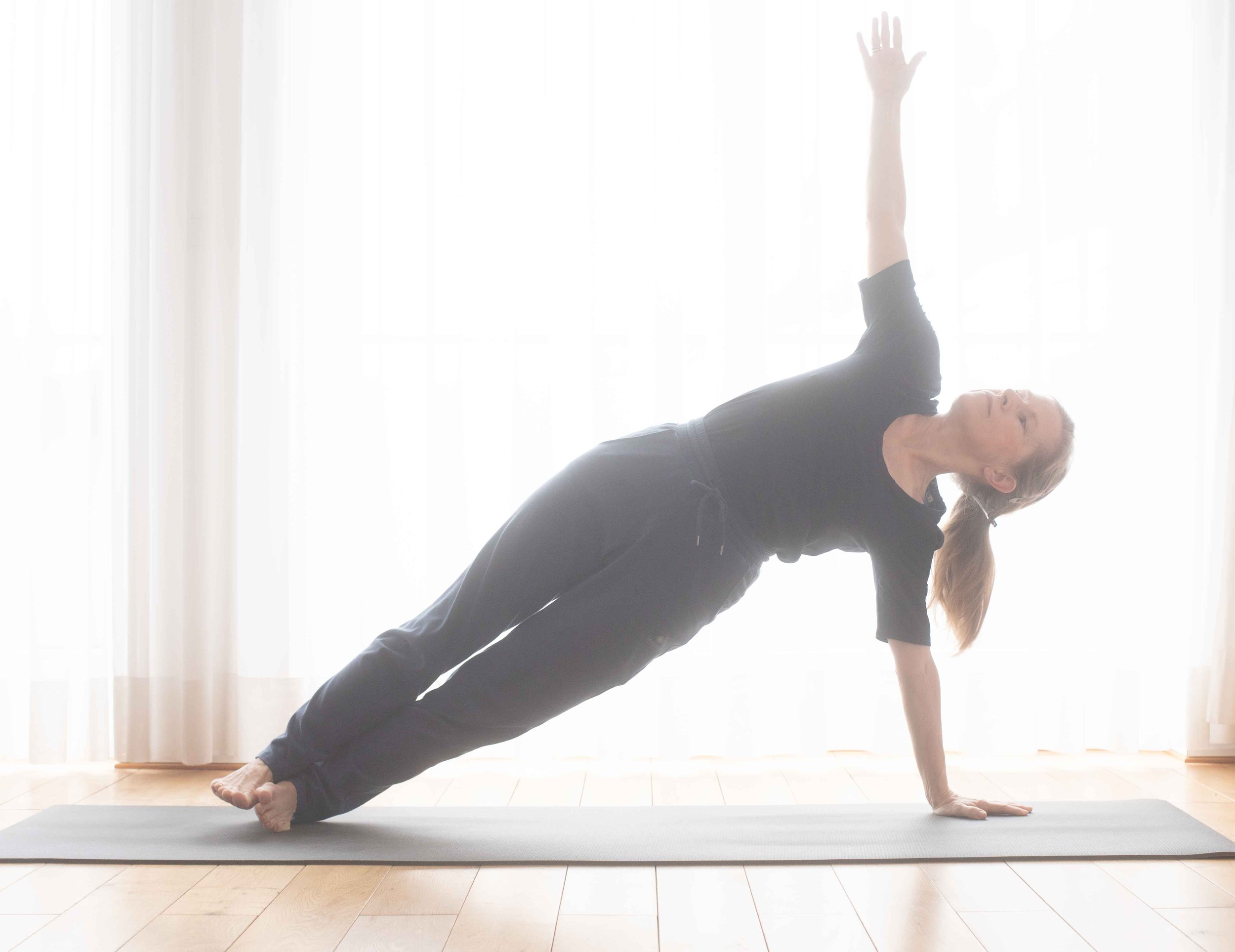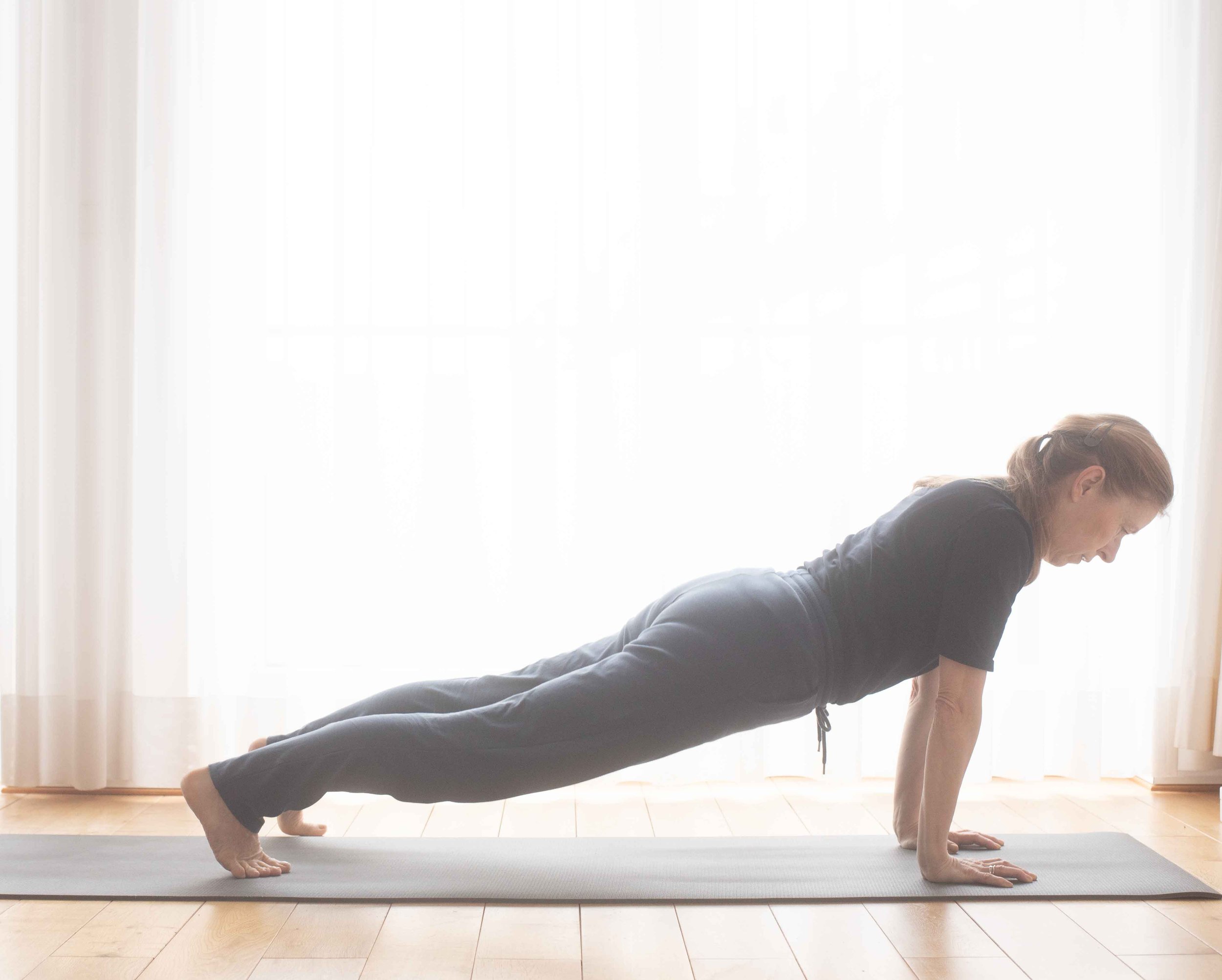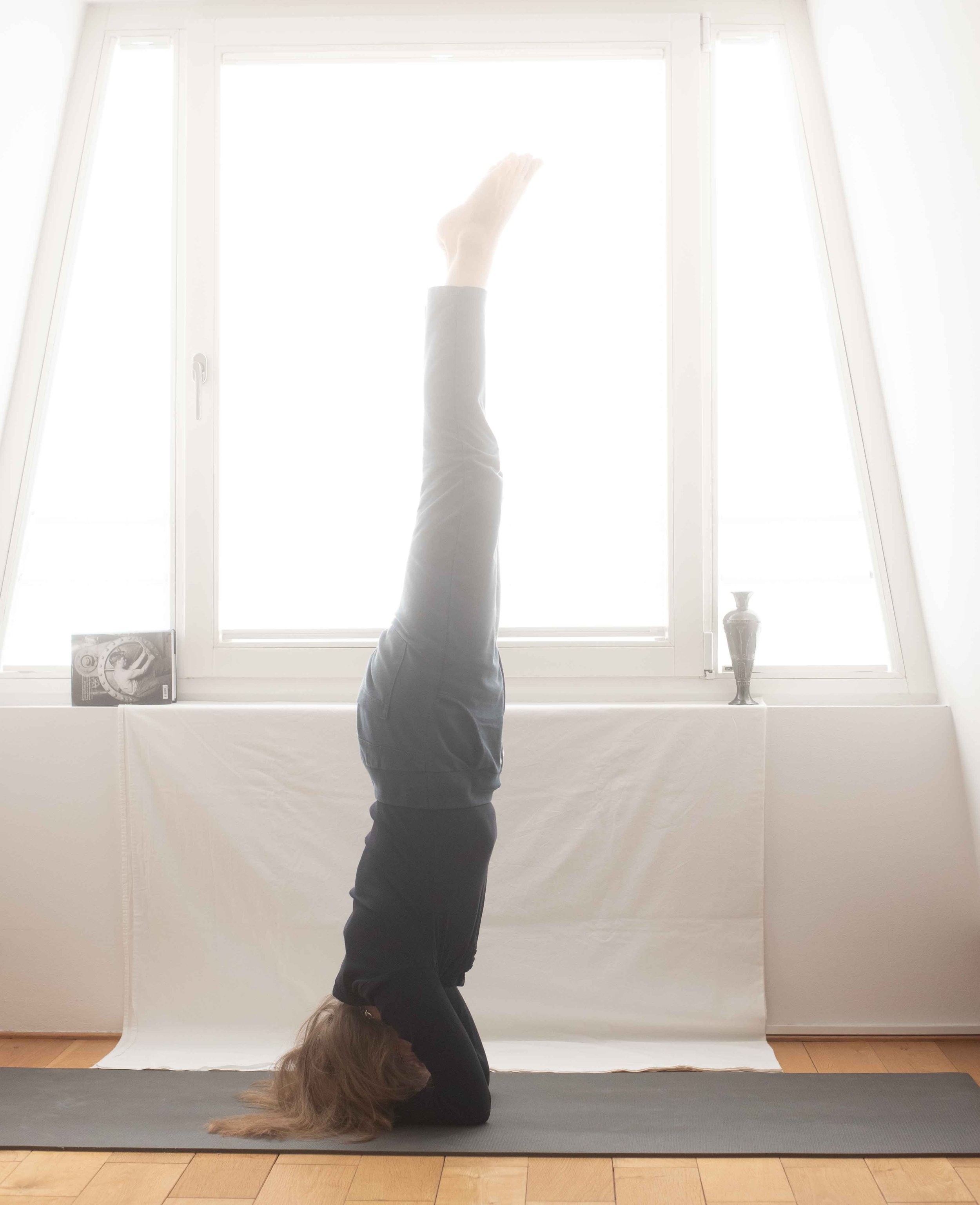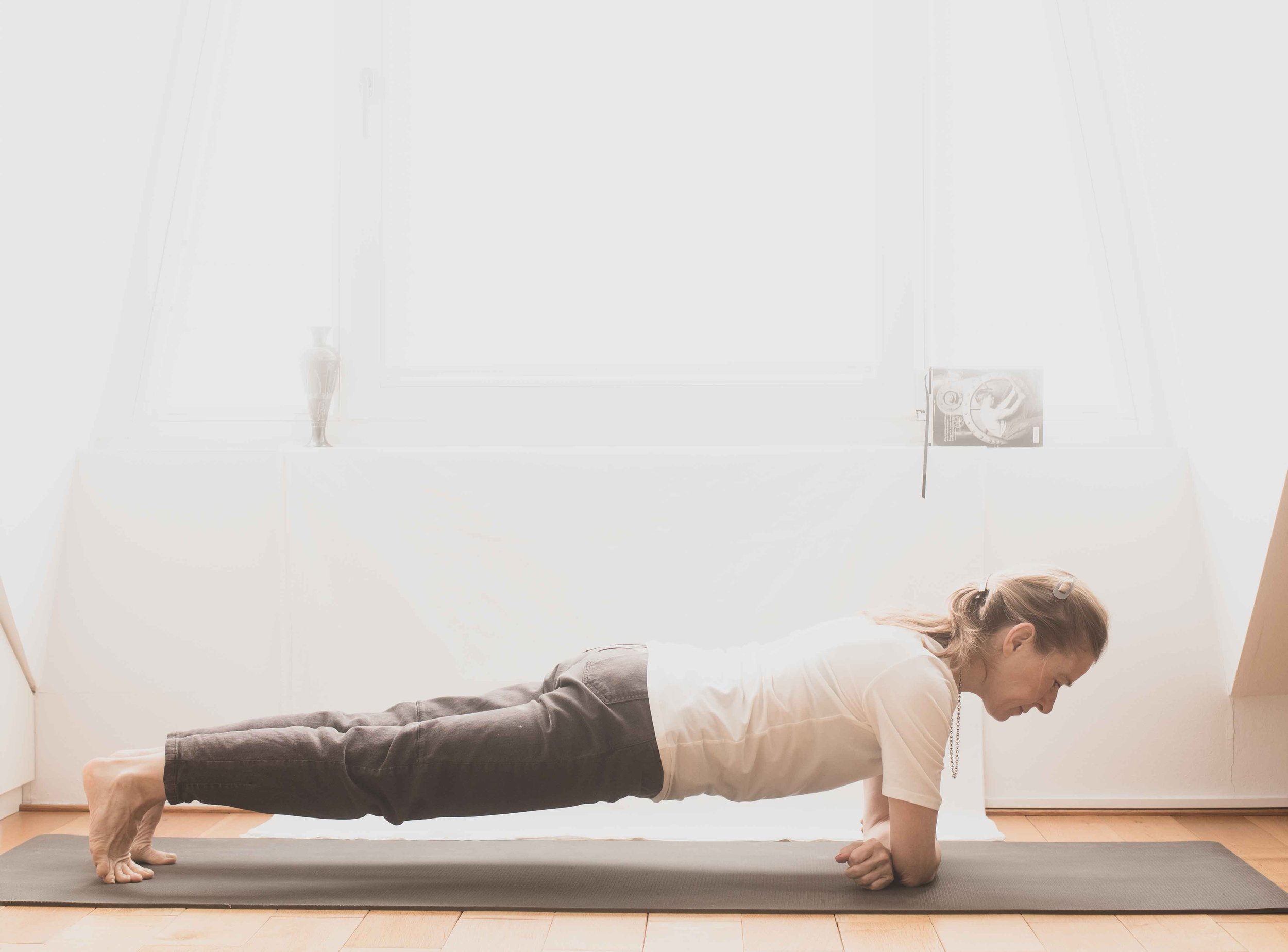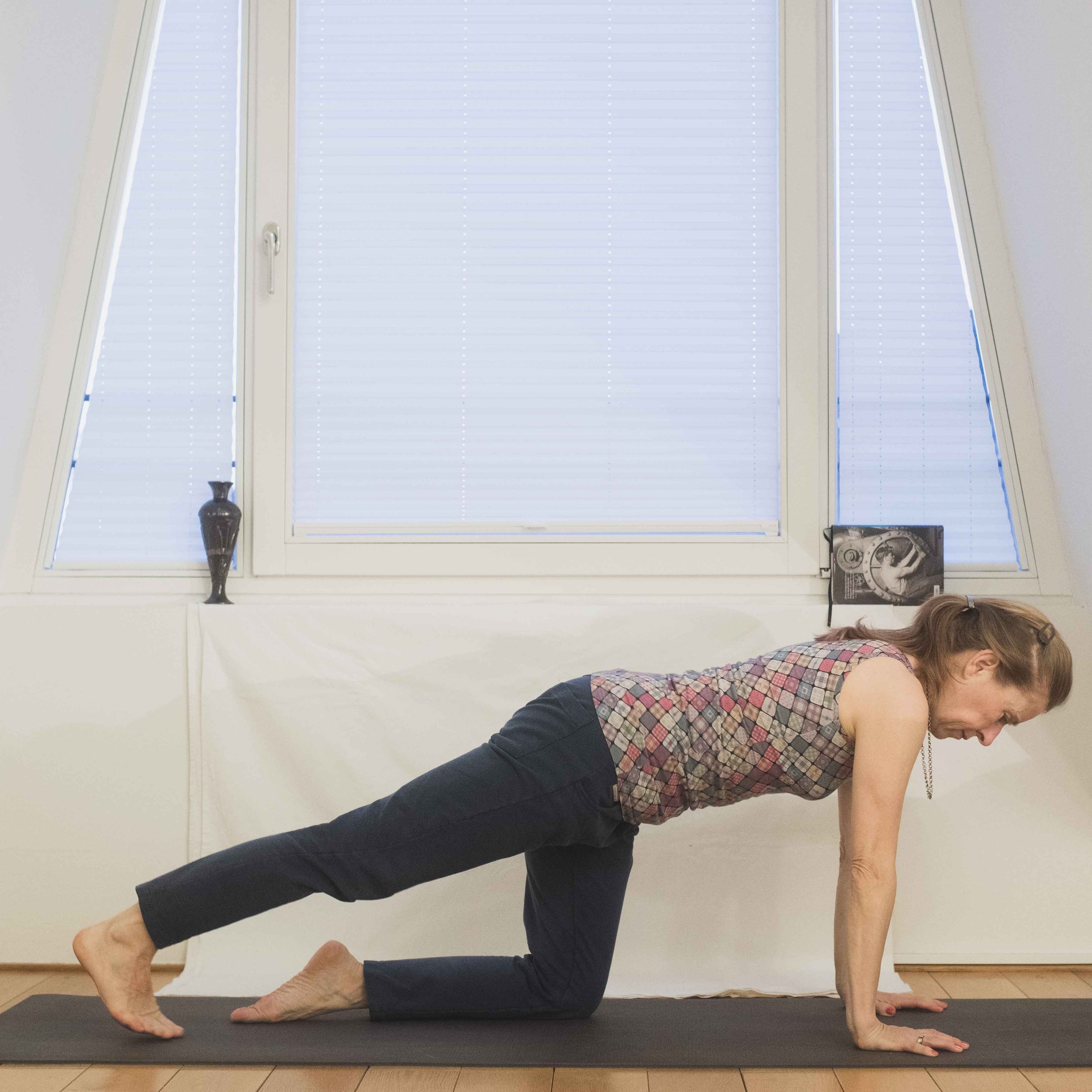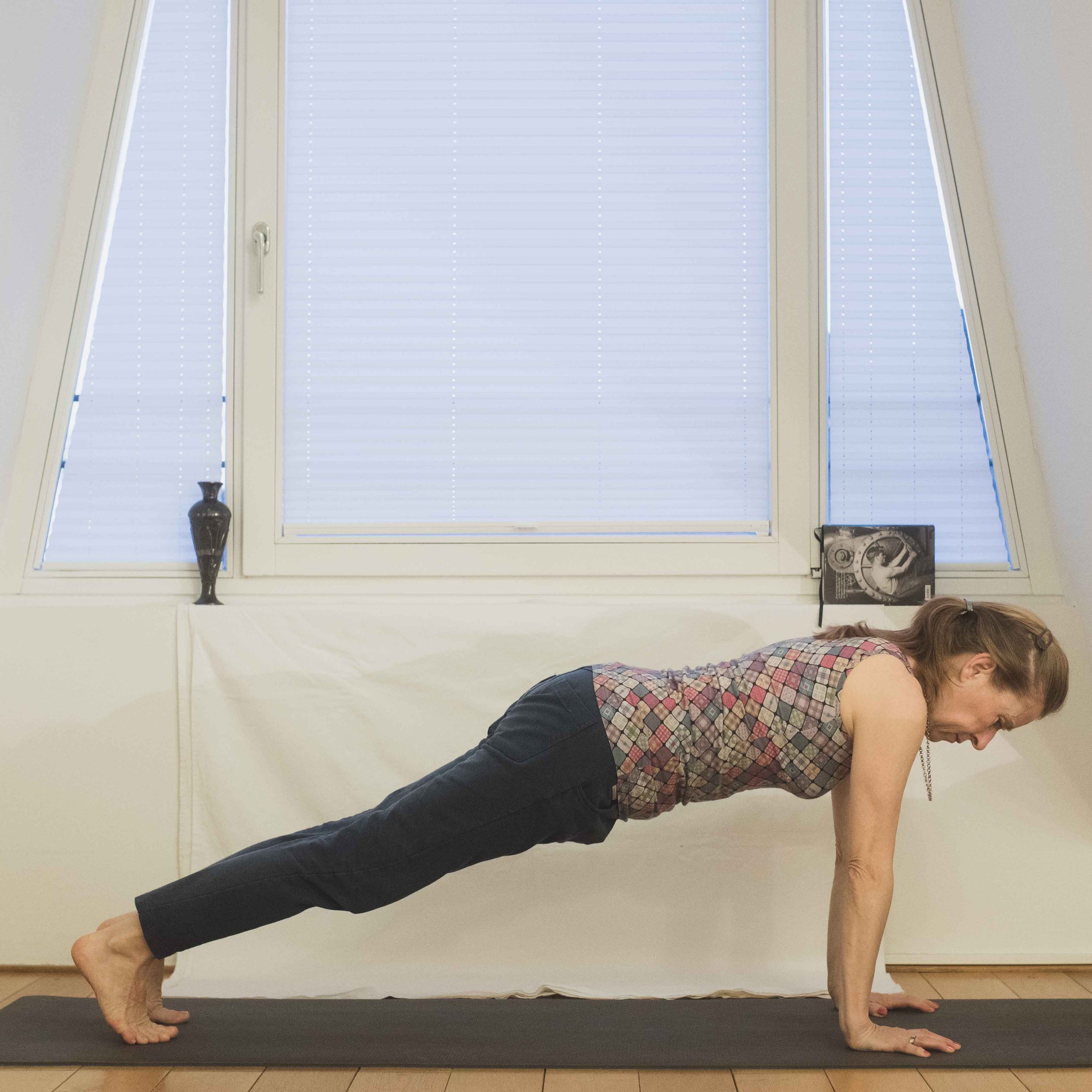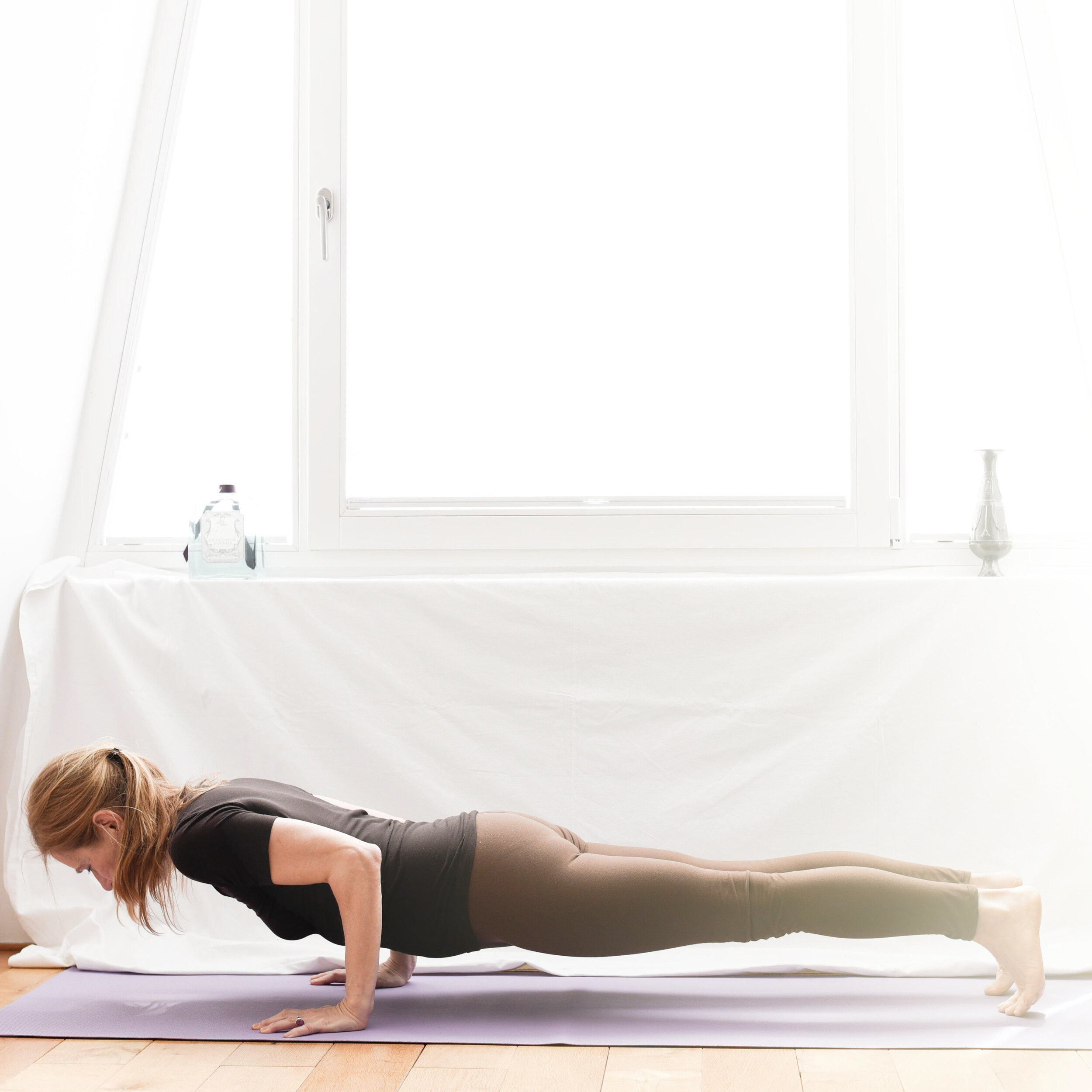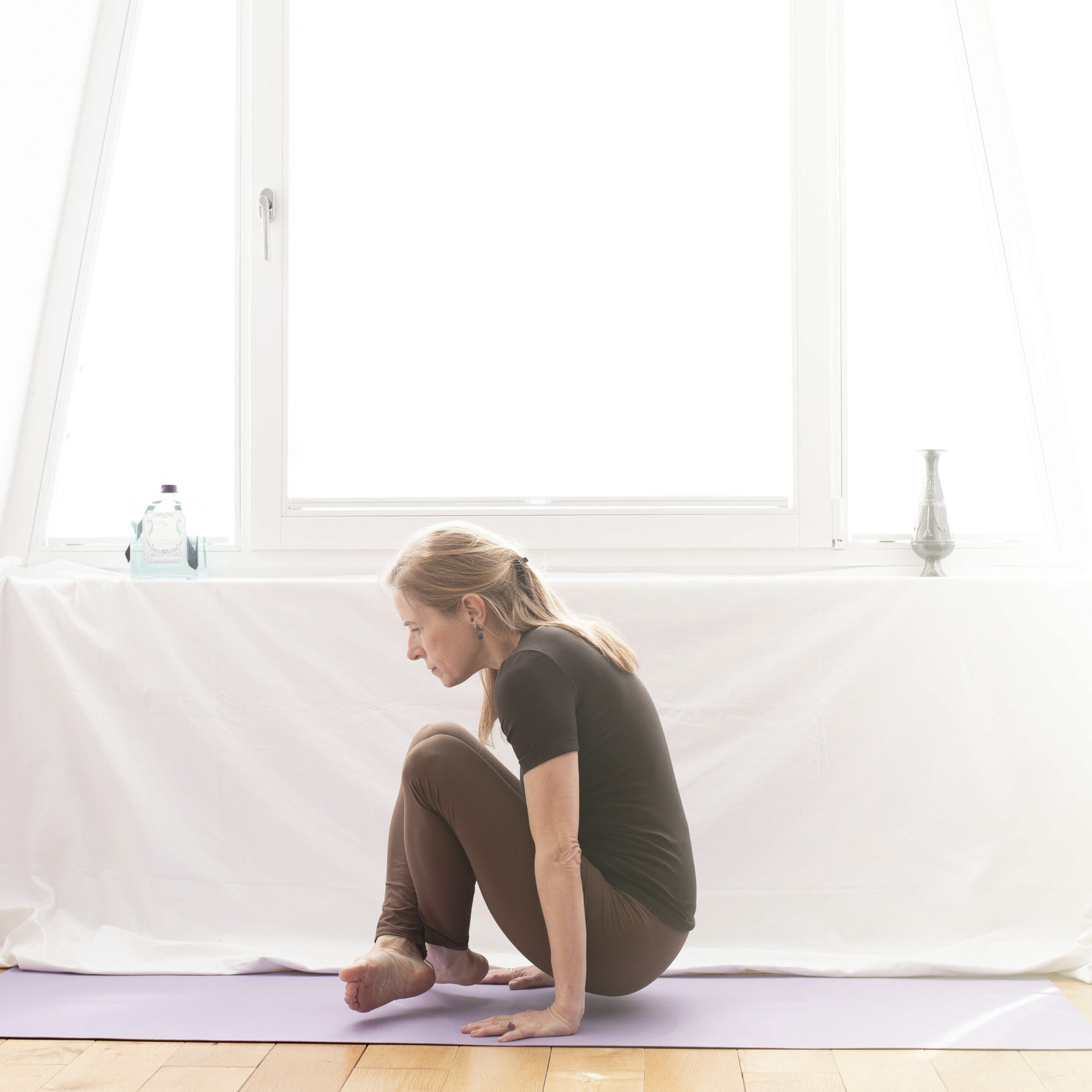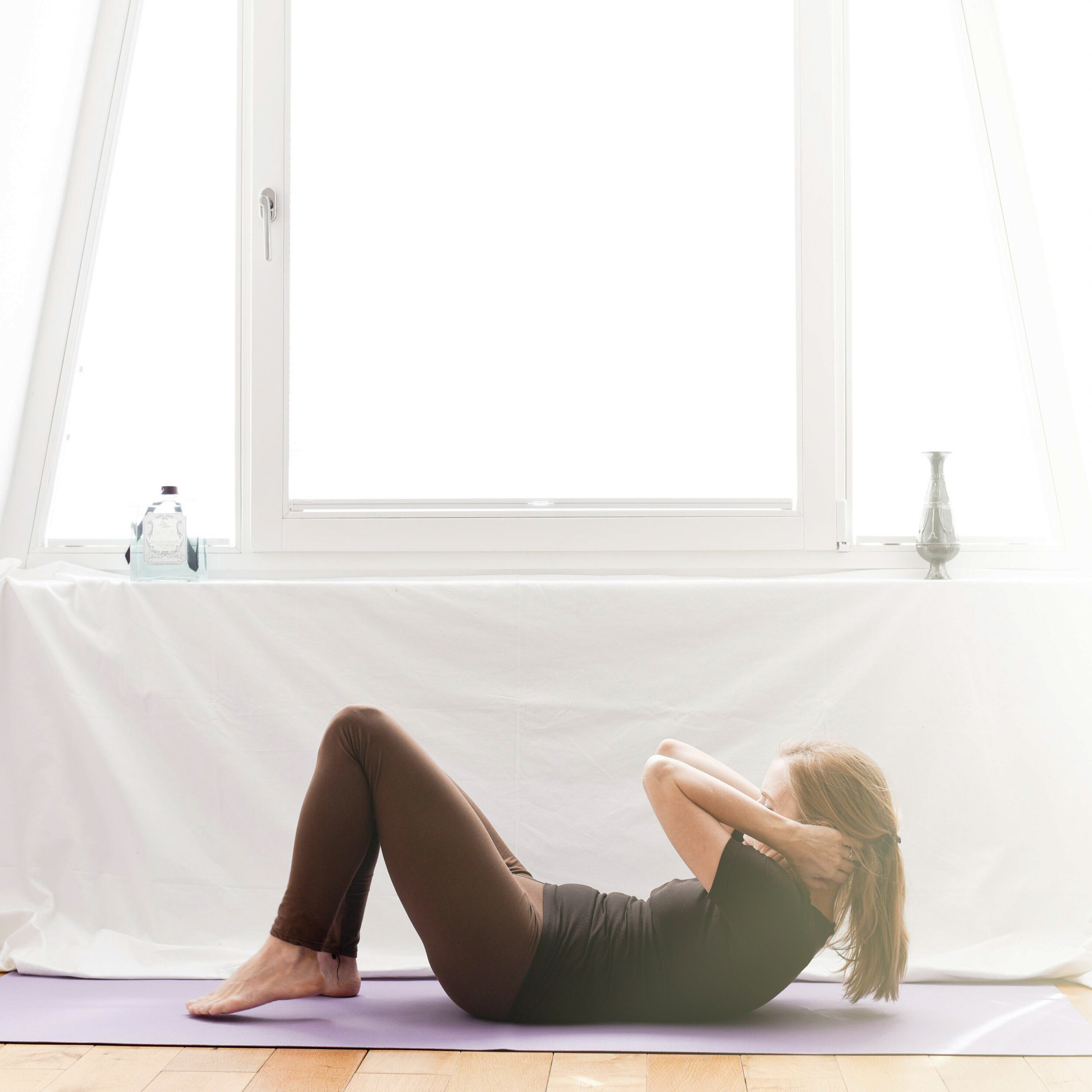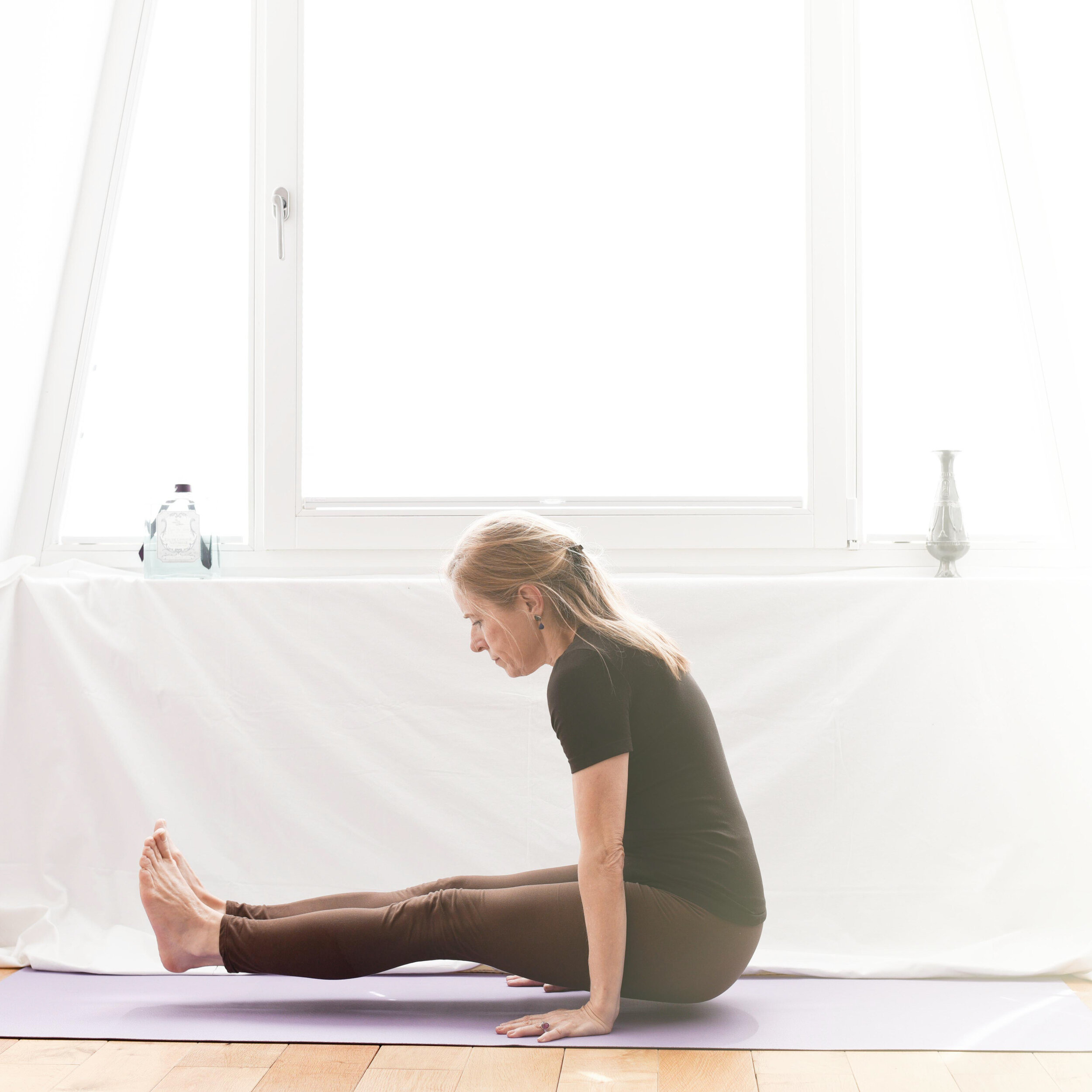Adding strength exercises to the yoga routine - planks.
Plank exercises can easily be incorporated into the sun salutations. It is a good idea to insert strength exercises before or after chaturanga dandasana.
Ultimately, chaturanga dandasana is a plank position.
The exercises are again taken from Sean Vigue's book '30 days of planks'.
In today's post, I present six more plank variations.
1st exercise:
Support yourself on your elbows. The body remains straight. Then bend your leg. Then change sides.
2nd exercise:
From a classic plank position with outstretched arms, first place the forearm of one arm on the floor, then the other. Then return to the classic position.
3rd exercise:
The hand touches the wrist of one arm. Then switch again.
4th exercise: The right hand touches the shoulder of the left side. Then switch again. This exercise was also recommended to me in the gym and becomes easier if you move your legs further apart. This makes it easier to balance.
5th exercise:
This is a side plank that I really like. It is a preparation for the 3rd Ashtanga Yoga series. The author also recommends changing sides quickly here. Since you are in a classic plank position as a transition, you can also add a push-up.
6th exercise:
One leg is moved to the side and then back again. The change follows immediately.
If you repeat the exercises up to 20 times, you will know what you have done.
These are just suggestions. It's best to pick out three favorite positions. If these get boring, try other variations.
Typical mistakes:
- When I looked at the pictures, I realized that the shoulders were not directly over the wrists. I was able to correct that.
- I also realized that my body wasn't really straight. You have to tighten your abdominal muscles to keep your body straight.
Have fun practicing.
Bala Kakasana, Kakasana and Bakasana
Let's start with the terminology. There is the baby crow, the crow and the crane. In Sanskrit, the three asanas are called bala kakasana, kakasana and bakasana.
You need strength to perform these three asanas. The muscles of the entire body are trained. The upper body carries the weight of the whole body. The abdomen must be tensed and pulled in. The legs must be kept in the air. All of this requires energy and strength.
I fooled myself once again with bala kakasana. This baby crow is also exhausting. I thought it would be an easy pose.
The nice thing is that you can integrate the postures well, for example after utkatasana. I usually practise bakasana after utkatasana. The special thing about bakasana is that the arms are stretched. I could do this pose before. I'm going to get it back again.
As a method for learning these asanas, I recommend repetitions and staying in the pose for longer.
Using the right technique is also very important. The hands are like claws. The upper body is rounded. The belly is pulled in. Bakasana becomes easier when the knees are close to the armpits. It is also easier to have the arms stretched from the beginning.
Have fun with the crow and the crane.
Why do we fall out of the headstand?
Sirsasana, February 2024
Why do we fall out of the headstand?
The better the technique, the less strength we need to hold the body in the pose. The straighter the body is, the more correct the position. The abdominal muscles are tensed to provide stability. The breath remains calm. The eyes remain relaxed.
I can see from the picture that I am not completely straight. Any tilt must be compensated for with strength.
Even if the pose is perfect, I have the feeling that I won't be able to hold myself up at some point. This is due to the lack of strength in my arms and shoulders. This strength can be built up by holding the pose a little longer each time. I use a timer for this, which has an interval function. There is a small sound every minute. This morning I held Sirsasana for 2 minutes. I felt that this was my limit today. The goal is 5 minutes.
I am very motivated because I have signed up for an asana coaching workshop at the end of February. It lasts 2 hours. Participants should let the yoga teacher know in advance which asanas or sequences they would like to practise. I wrote that I would like to move from headstand to scorpion. Scorpio is an intense backbend and a challenging balance pose at the same time. I don't know what possessed me to write something so difficult. Now I'm trying to prepare myself. I practise holding the headstand a little longer every day. Over the next few days, I will also practise the backward movement against the wall. I want my body to be optimally prepared.
This asana coaching workshop is definitely my yoga highlight in February.
Planks as a strength exercise
In my first blog post about planks, I described how to get into a classic incline. Ideally, the shoulders should be above the wrists. This way your arms are parallel to the wall. The wrists are not overloaded. The body is a straight inclined plank. Leg and especially the abdominal muscles are tensed.
There are many variations of this basic pose.
I got the ideas from Sean Vigue's book 'Thirty days of Planks'.
It is important to perform the positions correctly. You should also hold the postures for at least ten breaths. That's what Sean recommends. I tend to use a timer and set it to one minute.
The link is an affiliate link to Amazon. I earn a small commission with it.
The next variation is the side planks. Sean places his top foot on the floor. This makes it easier to balance. But you don't have to do this. For me, this pose is a preparation for Vasishasana, the first pose in the 3rd Ashtanga yoga series. I don't want to make the balance any easier for myself, especially as it's easy for me to do the pose when my feet are on top of each other.
It is easier to balance with indoor shoes. The pose was also recommended to me by the personal trainer at the gym.
It is important not to let the hips sink. The body should be parallel. It feels as if the hips have to be pushed forward.
Dristhi is the hand that stretches upwards.
This exercise can also be easily integrated into any Ashtanga yoga series.
The exercise is easier if you support yourself on your forearm.
This is followed by a dynamic variation of the plank pose. The right and left knee are alternately brought to the floor. The body remains straight. This is also an easy balancing exercise. The abdominal muscles remain tensed. Twenty repetitions are suggested. The outstretched leg presses backwards.
The exercises look simple, but they're really tough.
The left and right leg are alternately stretched upwards. The hips remain parallel or pull towards the floor. This exercise strengthens the gluteus muscle. It also stretches the hip flexor. This is another dynamic exercise that should be repeated up to 20 times.
These six plank variations will keep you busy for a good week. As with everything, daily practice is important. Next week I will introduce the next variations from Sean Vigue's book.
Let's be strong.
First Ashtanga Serie to build strength
Vinyasa preparation, February 2024
The vinyasas are probably the most strenuous part of the 1st Ashtanga Yoga series. At some point I gave up jumping through after each pose. But I want to slowly build up the strength to do the vinyasas again.
I will use the method of small steps. On Friday I realized that I can hold the vinyasas well during the first four poses. It's more or less cheating through, but still. Who can swing through well? Even at my best, I wasn't really doing it perfectly.
Now I'm working on lifting off the floor. I want to keep my knees together and as close to my shoulders as possible. That takes arm muscles, abs and hip muscles.
Even small victories are motivating. This morning I saw on the scale that the percentage of my muscle mass had increased slightly. I am now at 29.5% muscle mass. My first goal is to reach 30%, then 35%. I don't know if the weight machines are targeting exactly the muscles I need for yoga. But I can feel that I'm getting stronger in general. I have also been advised to do callisthenics. There is a large area in the gym where you can exercise freely. I like the wall bars there. After working out on the machines, I can also work out freely there and do planks, for example, or do the exact exercises I need to master the vinyasas.
The conditions are ideal.
There is enough knowledge of what to do.
Now it just needs to be done.
Knowing callisthenics exercises is useful because you don't always have a gym nearby. Sometimes you can't get out of the house. Squats, pushups, planks and other simple but challenging exercises can be done anywhere.
Saturday is my Ashtanga day off.
Sunday I start again with the 2nd series. I'm looking forward to it.
At a certain age you have to do some strength training. Yoga is not a fitness program, even though yoga aims to keep the mind, body and soul healthy.
Plank pose
Today marks the start of a new month. This was an opportunity to think about a focus. It immediately occurred to me that I could work on my strength. I have two books about planks in my Kindle library. One is by Sean Vigue and it's called 'Thirty days of Planks'. That's inspiration enough for me for now. When you practise planks, you train your whole body.
The pose looks easy, but it's not. If I hadn't taken any pictures, my inclined plank would have been pushed forward.
The shoulders should be above the wrists and not further forward or further back. To achieve this, I started by standing on four feet. This made it easier to get the arms into the right position. Ideally, they should be vertical to the wall.
The body should be straight, a straight inclined plank. There is a tendency to push the buttocks upwards. I suspect that this will make the position easier. To maintain the straight inclined plane, it is advisable to tense the abdominal muscles. The point of the exercise is to become stronger and not to hang in one position.
I noticed the feet in the pictures. I also wanted the soles of my feet to be parallel to the wall. So I took another picture. The body remembers correct postures, but first you have to do the pose correctly. Pictures provide feedback.
You are supposed to hold the position for 10 breaths. I think you can definitely increase this to one minute.
Planks can also be integrated well. You could insert them between the asanas of the 1st series or practice them after the sun salutations.
Plank pose, January 2024
Strength training
Germany, December 2023 - Usthrasana
If you want to stay fit in old age (60 plus), you have to do more than before and eat more intelligently. From the age of 40, your strength should start to decline. It doesn't matter when you notice it, but at some point you realize that you are getting weaker. The older you get, the more important it is to train your strength.
Some yoga exercises are so much harder for me than they used to be because I don't have the strength. The vinyasa of the 1st Ashtanga Yoga series are only rudimentary at the moment.
I have been doing strength training for a year now.
I recently changed gym because there is a gym nearby. Anything that is too far away, you do less often than you want to.
The new gym also took a medical history. That seems to be standard. You find out more about your own body values after registering at a gym than after a medical history at the doctor.
But what really motivates me is that I have another appointment with my trainer at the end of February. Then she will measure again how much strength I have and how high my fat percentage is. We are living in the decade of measurements and control. I take a critical view of this. But it also has advantages. Finding out where you stand is an advantage.
You can also sign up for a challenge every month in the app. Then you can see how many activity points you have collected compared to the others. I see that as positive competition. You're not floating in a vacuum with no direction. I immediately thought: I want to be in the top half. So I packed my sneakers on Friday and off I went. That's how people are.
There is a so-called EGym in the studio. These are 9 machines that train the most important muscles. This EGym was recommended to me.
Here are the machines that are supposed to make me stronger:
1. rowing machine
2. rotator
3. leg curl
4. abdominal trainer
5. chest press
6. lat pulldown
7. gluteus
8. back trainer
9. leg extension
When I log on to the individual machines, they are automatically set for me. I then move my 17 kg, 23 kg or whatever my current level is.
The circuit training is done twice. It takes about 45 minutes. Afterwards you know what you've done.
After that, you can train on other machines or do cardio training. I also got five callisthenics exercises. As a yogi, I don't forget to stretch at the end. I don't want to lose my flexibility. I was so happy when I saw two wall bars on the functional area. I do my last exercises on them before jetting home happily and exhausted.
What I learned (not new, but something I experience again and again):
- It's good to set yourself goals. I want to increase my muscle mass to over 30%.
- Being part of a group is very helpful.
- Regularity is important.
Keep practicing.
Can a person get stronger after 50?
Can a person get stronger after 50?
This was the question I read this morning on Qura before my yoga practice. I knew the answer. Of course a person above 50 can get stronger. Also a person above 60 and 70 and 80 can get stronger, if she is willing to do the work.
The author made clear, that if someone no matter what age wants to become stronger he/she must exercise to the point that the muscles start burning. This is experienced as pain. When the muscles start burning it’s important to keep pushing. No pain, no gain, is true. These little muscle injuries that happen when someone exercises hard enough get repaired by the body. We feel that we have sore muscles the other day. But through healing the muscles get stronger. The body needs time to repair the muscles, this is why strength training experts recommend to take a day off after an intensive training. Over-training should be avoided.
The issue is that most older people are not willing to put in the work. If someone used to exercise in her/his youth it’s easier to begin again. For those people who never moved or never did any sportive activities it’s probably a challenge.
When an exercises is mastered, the body keeps the status quo. This is why body builders and fitness experts recommend to change the exercises every 6 weeks. When a push-up is done with 2 arms, one can try to use only one arm. Squats can be done with one leg stretched and so on……
A strong core is important for every sportive activity. Dancing, running, skiing, gymnastic, you name it. It’s also important for yoga. Without strong abdomen and without strong arms the vinyasa are not possible.
A couple of weeks ago I was not able to do 5 sun salutations A and 3 sun salutations B. I practiced till I couldn’t hold my body anymore in chaturanga. Now it’s possible. Next week I’ll become 61, I’m the proof that one can get stronger if one is willing to practice.
The bad news is that if you stop practicing for only 1 week, 10% of the strength is gone again.
It’s best to keep practicing. Breaks are the beginning of set backs.
For me the reward is huge: Independence.
I want to be able to open my water bottles on my own till my last breath. I want to be able to walk around without technical help for as long as possible. Being able to do the chores and cooking on my own is also not that bad. Oh, and I almost forgot, I want to be able to carry my suitcase on my own. I hope that traveling will be able again after Corona.
Life needn’t to aggravate when we get older. If this is a wish strength training should become part of the daily or (almost daily) routine. As mentioned already it’s enough to train strength every second day. Strength training is different to stretching.
I prefer to stretch for sure. But being strong is equally important. I know the theory. I also know that it’s not easy to motivate myself to work on my strength. I try to integrate exercises in my daily yoga practice. Of course it could be good to do an extra session. 1% practice is better than 99% theory………
How to stay young?
How to stay young?
Avoid grey and beige in your clothes.
Smile more.
Have a passion.
It’s all true, but not enough.
I don’t know at what age it starts exactly, but surely above 60, people get weaker and stiffer. It’s possible to work against this natural development: Practice yoga, do strength training and work on your flexibility.
First a bit of theory regarding strength training:
It’s possible to integrate it in daily life. Take the steps and not the elevator is such an example.
One can integrate strength training in the daily yoga practice. For instance one can lift the body into urdhva dhanurasana (bridge pose) again and again. This makes strong arms.
Do extra strength training. It doesn’t take long. It’s exhausting. Results can be felt quickly.
The structure of strength training:
There are repetitions and sets.
Do as much repetitions as possible minus one. In sum do 3 sets of the same number of repetitions.
First you have to find out how many reps you’re able to do. If the reps become easy add more. Ten reps could be the goal. Ten reps are also enough for beginners. More is not necessary. Belief me, sometimes 5 reps are more than enough. If 5 reps are not possible, do more sets, till 5 reps are possible.
Source: Overcoming gravity by Steven Law. I read the German edition.
Which muscles are to exercise:
A human being has 650 muscles. 50 alone are in the face. The heart muscle is a most important muscle. Muscles around the lungs allow us to breathe. The tiniest muscle is behind the ears. I saw people who could move the ears. Yes, this is funny. Think of your tongue. When we practice yoga we engage the pelvis floor.
Muscles make 40 to 60 % of the body weight of men.
Muscles make 30 to 40 % of the body weight of women.
These general statements don’t help a lot as we’re individuals, but they can give an orientation.
To simplify everything: The body has a core and limbs (arms and legs), a front side and a back side. We can exercise these body parts.
I’m sure that I haven’t been able to perform some asanas because I lacked strength. Being strong stabilizes the body, it protects us from injuries.
In comparison to cardio training it’s very rewarding as it doesn’t require much time. The strength gurus recommend to take breaks. To train three times a week could be enough. The muscles must recover from the training.
There are static and dynamic exercises.
I think this was enough theory.
I recommend doing a search on muscles and strength training. It’s a very interesting topic.
Being strong makes daily life easier. I also want to exercise my muscles because I want to perform asanas that I’m not able to do. Yet.
————-
The sun is shining here. I sip my second black coffee. I had a banana for breakfast. I’m more than ready for the day.

